
Trusted News Since 1995
A service for global professionals · Tuesday, November 19, 2019 · 502,556,647 Articles · 3+ Million Readers

Trusted News Since 1995
A service for global professionals · Tuesday, November 19, 2019 · 502,556,647 Articles · 3+ Million Readers

After living in Cape Town for 20 years, Henry Trotter explores the unique character of the city while illuminating some of the hidden historical, political and cultural forces that shape its social life in his new book Cape Town: A Place Between. In this extract, Trotter shares what inspired him to come to this curious corner of the continent.
I first came to Africa in 1994 when South Africa teetered on a knife’s edge. In the months leading up to its first democratic elections that year, the country seethed with violence.
In KwaZulu-Natal, African National Congress (ANC) and Inkatha Freedom Party (IFP) loyalists were engaged in a vicious regional war, fomented by a shadowy “third force” within the apartheid security apparatus.
East of Johannesburg, the charismatic South African Communist Party (SACP) leader Chris Hani was assassinated at his home by two white men. Nelson Mandela himself had to beg the nation not to tear itself apart over this outrage.
And in Cape Town, the white American Fulbright student Amy Biehl was stabbed and stoned by young activists in Gugulethu township. They had just attended a rally where the cry of “one settler, one bullet” (kill the whites) still rang in their ears when they came across Biehl who was dropping off university colleagues.
As a 20-year-old student myself then, going into my third year of university in California and dreaming about where I could study abroad, South Africa was not an option. Not by a longshot.
It was still run by the National Party, the white supremacists who initiated apartheid and were scrambling to protect their privileges. And they were opposed by one of the most politically mobilised populations on earth, an “ungovernable” people who had been engaged in an endless series of protests, boycotts, stay-aways, strikes, and sabotage campaigns since the Soweto uprising of 1976.
I had to admit, from what I knew about the country then – through newspaper headlines mostly – I found South Africa to be thoroughly intimidating. Completely hard core. And its people seemed just a weeee bit intense.
So at the time, Zimbabwe was the place to go in Africa. Safe, stable, peaceful, with an excellent education system, Zim was a popular destination for college exchange programs. Renowned as “the breadbasket of southern Africa,” the country seemed poised for a bright future.
Seeking to expand my cultural horizons, I signed up to study African literature and the Shona language at the University of Zimbabwe (UZ) in Harare. I even wrote a letter to then-President Mugabe before I arrived, letting him know that I was excited to visit his country. (He never wrote back.)
During my year at UZ, I learned as much as I could about African history, culture, politics, and literature. I read widely and took advantage of the easy access that Zimbabweans offered of their time and thoughts.
And I also took trips to the rural areas and neighbouring countries, including South Africa after the surprisingly peaceful elections. Went twice to Durban, a beach bum’s paradise at the time.
But after UZ, I didn’t want my time in Africa to end, so I got a job teaching English literature at a ritzy private boys’ high school next to the president’s house in Harare. Steeped in Anglo-Rhodesian traditions, the racially diverse students wore white collared shirts, red ties, khaki shorts, knee-high socks, blazers, and floppy cricket hats. They would stand and doff their caps, saying “Sir,” whenever I passed by.
Sadly, such courtesy did not extend to the country’s immigration officers who denied my application for a visa extension after six months of teaching. Apparently, I didn’t have any “essential skills” that Zimbabwe couldn’t live without. (I still don’t.)
So, I strapped on my backpack and started wandering around East Africa, plodding through Malawi, Zambia, and Tanzania, then up to Uganda, Rwanda, and Burundi, then east to Kenya, and north to Ethiopia and Eritrea. Then I flew over to Madagascar and Mauritius for some months, then back to southern Africa again to explore Mozambique, South Africa, Namibia, and Botswana, eventually ending my sojourn in Cameroon.
Four years. Seventeen countries. It was awesome!
But as I travelled, I embarked on a personal mission. Everywhere I went, I searched out bookshops and bought as many local titles as I could find. Then I’d read them while in the country, inviting the literary renderings of these artists to enhance my own experiences.
This massively expanded my mental and emotional engagement with these places. It was in this way that I first got a glimpse of Cape Town, through a book I found while recovering from bilharzia in Lilongwe, the capital of Malawi. (Bilharzia is a liver fluke I got from swimming in Lake Malawi. Not pleasant. Don’t google it.)
I took the strangely titled novel, Buckingham Palace: District Six, back to my fleabag hotel-cum-brothel next to the bus station and devoured it. Even with all the noises permeating the flimsy room partitions, I began to glimpse a curious world that I had yet to encounter in my travels on the continent. One that challenged my notions of the complexity, diversity and cultural parameters of “Africa.”
It was a creole world. A mixed world. An in-between world. It stood between the conceptions that I had always taken for granted about Africa and Europe, black and white, east and west. An unsettling and intriguing world. One that I would definitely have to see for myself.
Written by Richard Rive, Buckingham Palace tells the story of the residents of a block of flats in District Six, the historical heart of Cape Town’s coloured population. Written after the district was destroyed by apartheid bulldozers, the book recounts the sights, sounds, personalities, and wit of the area.
It revels in the vitality of the street life, the inventiveness of the mixed Afrikaans and English speech (Kaapse taal), and the quality of the relationships between the people there of all racial backgrounds.
Here was a story about a place similar to Harlem for African-Americans in its cultural and historical import for a group of people that I knew almost nothing about: Cape coloureds. A people, I’d soon learn, whose presence in this corner of the continent challenged any simplistic answers to the question of, “Who is an African?”
* This extract was taken from Cape Town: A Place Between by Henry Trotter, published by Catalyst Press. Trotter is the author Sugar Girls & Seamen: A Journey into the World of Dockside Prostitution in South Africa. This is Trotter’s third book, and the first in the Intimate Geographies Series by Catalyst Press.
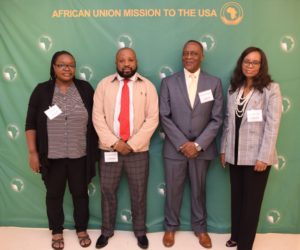
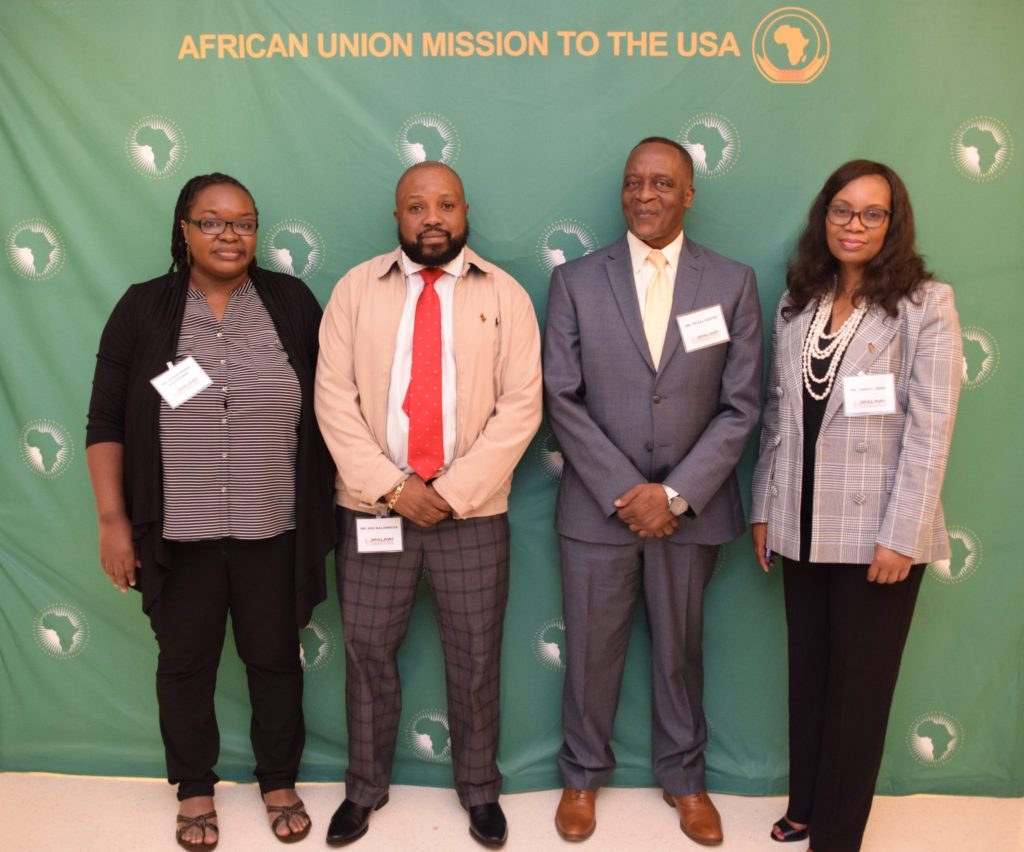
In a letter sent out to various Malawi organizations in USA States and made available to The Maravi Post, Malawi Ambassador in the USA, Edward Y. Sawerengera writes the following:
I have the honor to inform you that, after consultations with leaders of various Malawi Diaspora organizations and associations in the USA, and as one of the agreed outcomes of the 2018 Malawi Diaspora Conference, the Embassy was
designated to solicit ideas from Malawians living in the USA on the formation of a Malawi Diaspora organization in the USA.
The organizing committee of the Malawi Diaspora Conference put up an interim committee to solicit ideas on how the organization would function. The committee consists of Dr Linda Semu, (Interim Chair) with members as follows: Mr. Felix Lindeire, Dr Sitinga Kachipande, Mr Ken Malomboza, Ms Patricia Kankondo, Ms Christina Kamkosi, Mr Mwiza Munthali and Ms Agnes Nkhata-Blackwood.
I emphasize that this committee is only temporary, and its main role is to translate your vision and ideas of what such an organization would entail. It is important that we get wide participation from Malawians living in the USA in the process of putting up this organization. In this respect, I humbly request your office, to advise your membership that they can send their ideas to malawidiaspora@gmail.com.
The interim committee will compile the ideas and I will get back to you with any agreements that may be collected.


– This year the Worldwide Web is thirty years old. For the first time since 1435, a citizen from Brazil could exchange their views and information with another in Finland.
The Internet, the communications infrastructure for the Web is a little older. It was developed from the ARPANET, a US Defense Department project under the Advanced Research Projects Agency; the military designing it to decentralize communications in the case of a military attack.
That network enabled scientists to communicate over email in universities. Then in 1989 Tim Berners-Lee at CERN in Switzerland invented the Hyperlink and the Worldwide Web (the Web) rapidly moved from scientists automating information sharing between universities and research institutions to the first Websites now available to the general public.
In 2002 the first social media sites began as specialised websites. LinkedIn launched in 2003 then FaceBook in 2004, Twitter in 2006, Instagram in 2010 and so on…
My generation regarded the arrival of the Web as a great prospect for democracy. We come from the Gutenberg era, an era that in 1435 changed the world. From manuscripts drafted by monks to be read by a few people in monasteries, the invention of reusable movable type meant that in just 20 years already eight million copies of printed books went all across Europe.
Among many other things it also meant the creation of information. People who heretofore had merely a scant horizon beyond their immediate surroundings, could suddenly access information about their country, and even the entire world. The first newspaper was printed in Strasbourg in 1605. From then until 1989, the world was filled with information.
Information had a very serious limit. It was a vertical structure. Just a few people sent news to a large number of recipients; there was little feedback. It wasn’t participatory, it required large startup investments, it was easily used by economic and political powers.
In the Third World, the media system was part of the State. In 1976, 88% of World news flows emanated from just three countries: the US, the UK and France. International news agencies based in these three countries included Associated Press (AP), United Press International (UPI), Reuters and Agence France Press (AFP).
The world’s media were dependent on their news services. Some alternative news agencies, like Inter Press Services, were able to put a dent in their monopoly. But what this Western media published, by and large was a biased window on the world.
Then came the Internet, and with it, came horizontal communication. Every receiver was also a sender. For the first time since 1435, media were no longer the only window on the world. Like-minded people could take part in social, cultural and economic interactions.
This change was evident in the United Nations Woman’s World Conference in Beijing, 1995. Women created networks prior to the conference, and came with a common plan of action. Governments were not so prepared, so the Declaration of Beijing was a turning point, one which was entirely unlike the bland declarations from the previous four World Conferences.
Another good example is the campaign to eliminate anti-personnel landmines, started by the Canadian activist Jody Williams in 1992. This soon blossomed into a large coalition of Non-Governmental Organizations from more than 100 countries.
Under mounting pressure Norway decided to introduce the issue to the UN, where the US, China, and other manufacturers of landmines like the USSR, tried to block the debate, declaring that they would vote against it.

Roberto Savio
The activists did not care, and 128 countries adopted the Mine Ban Treaty in 1997 with the US, China and the USSR voting against. A vast global movement was more powerful than the traditional role of the Security Council. The Internet had become the tool to create world coalitions.
Those are just two examples of how far the Internet could change the traditional system of Westphalian state sovereignty as defined at the Conference of Westphalia in 1648. The Internet spanned national frontiers to bring on a new era.
Let’s say, for the sake of symbolism, that the Internet brought us from the Gutenberg Era, to the Zuckerberg Era, to cite the inventor of Facebook and a leading instance of what went wrong with this medium.
The Internet came upon us with an unprecedented force. It took 38 years for the radio to reach 50 million people: television took 13 years; and the Web just four years. It had a billion users in 2005, two billion in 2011, and it now has three and a half billion users, three billion of those using social media.
So the two traditional pillars of power, the political system and the economic system, also had to learn how to use the Internet. The US provides a good example. All of American media (national and regional publications) involves printing 50 million copies daily.
Quality newspapers — both the conservative broadsheets like the Wall Street Journal, and progressive ones like the Washington Post or the New York Times — together print ten million copies a day. Trump has sixty three million followers on Twitter; they read Trump’s tweets but don’t buy newspapers.
The Web has had two unforeseen developments. One was the dramatic reinforcement of the consumer society. Today advertising budgets are ten times larger than budgets for education, and education only lasts a few years compared with a lifetime of advertisement.
With the development of social networks, people — now more consumers than citizens — have become objects for marketing goods and services, and recently also for political campaigns. All systems of information and communications extract our personal data, selling us on as consumers.
Now the TV can see us while we watch it. Smartphones have become microphones that listen in on our conversations. The notion of privacy is gone. If we could access our data, we would find out that we are followed every minute of the day, even into our bedrooms.
Secret algorithms form profiles of each and every one of us. Based on these profiles platforms provide us with the news, the products, and the people that these algorithms believe we will like, thus insulating us in our own bubbles.
Artificial intelligence learns from the data that it accumulates. China, with 1.35 billion people, will provide its researchers with more data than Europe and United States together. The Internet has given birth to a digital extractive economy, where the raw material is no longer minerals, but we humans.
The other development that went awry is that the digital extractive economy has created unprecedented wealth.
Amazon CEO Jeff Bezos was recently divorced from his wife. In the settlement she received 36 billion dollars yet Bezos remains among the 10 richest people in the world. This is just one story from an increasingly sad reality of social injustice, where 80 of the world’s richest persons hold the same wealth as nearly three billion poor people.
A new sector is evolving, the “surveillance capitalism” sector, where money is made not from the production of good and services, but from data extracted from people.
This new system exploits humans to give to the owners of this technology, a concentration of wealth, knowledge and power without precedent in history. The ability to develop facial recognition and other surveillance instruments no longer lies in the realms of science fiction.
The Chinese government has already given every citizen a digital number, where all their ‘good’ and ‘bad’ behaviours converge. If a citizen goes below a level, their children will not be allowed to go to a good school, and the citizen themselves, though they may still be able to travel by train, won’t have access to planes.
These technologies will soon be in use all over the planet. London town now has 627,000 surveillance cameras, one for every fourteen citizens; in Beijing it’s one for every seven. A study conducted by The Rand Corporation estimates that by 2050, Europe too would also have one camera for every seven citizens.
The interrelationship between democracy and the Internet is now creating a belated awareness in the political system. The European Parliament has just released a study, about the negative impact of the Internet. These impacts are:
We should add to this study some other considerations. The first is that finance now is now also run by algorithms. The algorithms do not only decide when to sell or buy shares, but now also decide where to invest.
The Exchange-Traded Funds (ETFs) last month reached 14,400 billion dollars in trades, more than that traded by humans. This trend will continue with the development of artificial intelligence and soon finance will become even more dehumanized. Even when Internet users invest themselves they too will be directed by machines and algorithms.
A second consideration is that young people read less and less. Reading a book is very different to scrolling a screen. We are experiencing a progressive reduction in levels of culture. It’s not uncommon to have university students that make grammar and spelling mistakes.
Let us remember that when the Internet was still new, its proponents told us: it is not important to know, rather it is important to know how to find. We are more and more dependent on search engines, learning less and less, and we are unable to connect that data in a personal holistic logical system.
There is clearly a need for regulation to reduce the negative aspects of the Internet and to reinforce positive values. The owners of social media platforms are now under increased scrutiny so they have taken the road of self-regulation.
Twitter, for instance, has decided that it cannot be used for political purposes. Zuckerberg is an exponent of market myths telling us that good news will automatically prevail over fake news. Except that platforms help users to read and find only what they like, to maintain our attention, providing us what is striking, unusual and provocative. This is not a free market.
The Zuckerberg era is clearly creating an entirely different generation, very different from the generations of the Gutenberg era. This raises many questions, from privacy to freedom of expression (now in private hands), from who will regulate, what to regulate and how.
A five year-old child is now very different from a Gutenberg five year-old. We are in a period of transition. The meaning of democracy is changing. International relations are moving away from the search for common values via multilateralism, to a tide of nationalist, xenophobic and selfish views of the world.
Terms like peace, cooperation, accountability, participation and transparency are becoming outdated. What is clear is that the present system is no longer sustainable. Policies disappear from debate, now referred to only as ‘politics’. Vision and paradigms are getting scarce.
Over and above all of this the threat of climate change is looming; yet last year toxic emissions from the five largest countries increased by 5%. Young people are largely absent from political institutions as is shown by the vote on Brexit where only 23% of the 18-25 age group participated.
At this very moment we have large demonstrations in thirteen countries all over the world. In those streets young people do participate, frequently demonstrating rage, frustration and violence. If we cannot bring back horizontal communication to the Internet and we do not free it from the commercial fracturing of young people, the future is hardly rosy.
Yet as the marches against Climate Change clearly demonstrate, if young people want to change the world, values and vision will return. It is evident that the Internet can be a very powerful tool. But who will redress these failings? Will the Internet become a tool for participation? How will this be done?
These are questions that political institutions, if they really care for democracy, must address as soon as possible. The Zuckerberg era must make this choice now, in a few years time it will already be too late…
Publisher of OtherNews, Italian-Argentine Roberto Savio is an economist, journalist, communication expert, political commentator, activist for social and climate justice and advocate of an anti neoliberal global governance. Director for international relations of the European Center for Peace and Development.. He is co-founder of Inter Press Service (IPS) news agency and its President Emeritus.
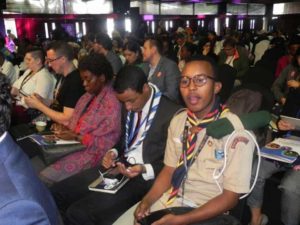
We need to empower young people to sustain our planet, and let peace and prosperity thrive says UN’s Resident Co-ordinator in Kenya, Siddharth Chatterjee speaks to IPS on reflections on the ICPD25 Summit.
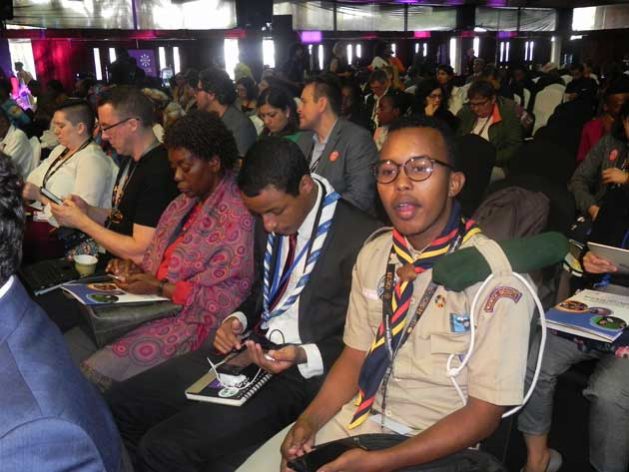
Young people at ICPD25 youth session. Credit: Mantoe Phakathi / IPS
– Q: At ICPD25 we heard that women and girls are still waiting for the unmet promises to be met? DO you think this time around there is a commitment to ensure that these promises are met?
The Nairobi Summit is about the Future of Humanity and Human Prosperity.
We all have an opportunity to repeat the message that women’s empowerment will move at snail-pace unless we bolster reproductive health and rights across the world. This is no longer a fleeting concern, but a 21st century socio-economic reality.
We can choose to take a range of actions, such as empowering women and girls by providing access to good health, education and job training. Or we can choose paths such as domestic abuse, female genital mutilation and child marriages, which, according to a 2016 Africa Human Development Report by UNDP, costs sub-Saharan Africa $95 billion per year on average due to gender inequality and lack of women’s empowerment.
Fortunately, the world has made real progress in the fight to take the right path. There is no lack of women trailblazers in all aspects of human endeavour. It has taken courage to make those choices, with current milestones being the result of decades of often frustrating work by unheralded people, politics and agencies.
Leaders like the indefatigable Dr. Natalia Kanem the Executive Director of UNFPA and her predecessors, are pushing the global change of paradigm to ensure we demolish the silo of “women’s issues” and begin to see the linkages between reproductive rights and human prosperity.
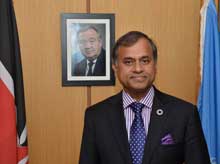
Siddharth Chatterjee
Numerous studies have shown the multi-generation impact of the formative years of women. A woman’s reproductive years directly overlap with her time in school and the workforce, she must be able to prevent unintended pregnancy in order to complete her education, maintain employment, and achieve economic security.
Denial of reproductive health information and services places a women at risk of an unintended pregnancy, which in turn is one of the most likely routes for upending the financial security of a woman and her family.
As the UN Resident Coordinator to Kenya, I am privileged to serve in a country, which has shown leadership to advance the cause of women’s right-from criminalizing female genital mutilation to stepping up the fight to end child marriage and pushing hard on improving reproductive, maternal and child health.
Q: At ICPD25 we heard that innovative partnerships are needed to ensure commitments to women and girls. 25 years on do you think this will happen? Can you site an example in Kenya or Africa on this?
Achieving the SDGs will be as much about the effectiveness of development cooperation as it will be about the scale and form that such co-operation takes. There is a lot of talk about partnership, but not enough practical, on-the-ground support to make partnerships effective in practice, especially not at scale.
Under the leadership of the Government of Kenya therefore, the UN System in Kenya in 2017 helped to spearhead the SDG Partnership Platform in collaboration with development partners, private sector, philanthropy, academia and civil society including faith-based stakeholders.
The Platform was formally launched by the Government of Kenya at the UN General Assembly in 2017 and has become a flagship initiative under Kenya’s new UN Development Assistance Framework 2018-2022 (UNDAF). As the entire UNDAF, the Platform is geared to contribute to the implementation of Kenya’s Big Four agenda in order to accelerate the attainment of the Country’s Vision2030.
In 2018, the Platform has received global recognition from UNDCO and the Dag Hammarskjold Foundation as a best practice to accelerate SDG financing. This clearly implies that we are on the right track, and as you can read in this report are developing a blueprint for how 21st Century SDG Partnerships can be forged and made impactful, but much more needs to be done.
Primary Healthcare (PHC) – in the SDG 3 cluster – has been the first SDG Partnership Platform window contributing to the attainment of the Universal Health Coverage as a key pillar of the Big Four agenda. We are living in a day and age where we have the expertise, technology and means to advance everyone’s health and wellbeing. It is our moral obligation to support Kenya in forging partnerships, find the right modalities to harness the potential out there and make it work for everyone, everywhere.
With leadership as from my co-chairs, Hon. Sicily Kariuki, Cabinet Secretary for Health in Kenya, and H.E Kuti, Chair of the Council of Governors Health Committee and Governor of Isiolo, and the strong political commitment, policy environment, and support of our partners we have in Kenya, I am convinced that Kenya can lead the way in attaining UHC in Africa, and accelerate the implementation of the ICPD25 agenda.
Q: Funding remains a crucial challenge- do you think there is a commitment to fund the initiatives?
Yes, there is a clear commitment to fund the ICPD Plan of Action.
I applaud partners whom have been doing so for long as the governments of Denmark, Netherlands, Sweden, Finland, Norway, and UK, and Foundations as the Bill and Melinda Gates Foundation.
But increasingly there is also the recognition that we cannot reach our ambitions through aid and grants.
At the global scale we need to let better regulation evolve for advancing greater equality and support to those furthest left behind.
Especially within middle-income-countries / emerging economies, our ICPD25 funding models need to be underpinned by shared-value approaches, and financed through domestic and blended financing.
I feel encouraged therefore by the Private Sector committing eight (8) billion fresh support to the acceleration of the ICPD Plan of Action.
Considering the trillions of dollars being transacted however by the private sector, this should be only the start and we should continue to advocate for bigger and better partnership between public and private sector targeting the communities furthest left behind to realize ICPD25.
Q: What do you think should be done to ensure young people’s participation?
Africa’s youth population is growing rapidly and is expected to reach over 830 million by 2050. Whether this spells promise or peril depends on how the continent manages its “youth bulge”.
Many of Africa’s young people remain trapped in poverty that is reflected in multiple dimensions, blighted by poor education, access to quality health care, malnutrition and lack of job opportunities.
For many young people–and especially girls– the lack of access to sexual and reproductive health services is depriving them of their rights and the ability to make decisions about their bodies and plan their families. This is adversely affecting their education and employment opportunities.
According to UNDP’s Africa Human Development Report for 2016, gender inequalities cost sub-Saharan Africa US$ 95 billion annually in lost revenue. Women’s empowerment and gender equality needs to be at the top of national development plans.
Between 10 and 12 million people join the African labour force each year, yet the continent creates only 3.7 million jobs annually. Without urgent and sustained action, the spectre of a migration crisis looms that no wall, navy or coastguard can hope to stop.
Africa’s population is expected to reach around 2.3 billion by 2050. The accompanying increase in its working age population creates a window of opportunity, which if properly harnessed, can translate into higher growth and yield a demographic dividend.
In the wake of the Second World War, the Marshall Plan helped to rebuild shattered European economies in the interests of growth and stability. We need a plan of similar ambition that places youth employment in Africa at the centre of development.
In the meantime, the aging demographic in many Western and Asian Tiger economies means increasing demand for skilled labour from regions with younger populations. It also means larger markets for economies seeking to benefit from the growth of a rapidly expanding African middle class.
Whether the future of Africa is promising or perilous will depend on how the continent and the international community moves from stated intent to urgent action and must give special priority to those SDGs that will give the continent a competitive edge through its youth.
The core SDGs of ending poverty, ensuring healthy lives and ensuring inclusive and equitable quality education all have particular resonance with the challenge of empowering youth and making them effective economic citizens.
Many young people in Africa are taking charge of their futures. There is a rising tide of entrepreneurship sweeping across Africa spanning technology, IT, innovation, small and medium enterprises.
They are creating jobs for themselves and their communities.
We need to empower young people to sustain our planet, and let peace and prosperity thrive.
Q: Lastly, we heard strong commitments from President Uhuru Kenyatta on the issue of FGM- do you think it will really happen by 2022?
President Uhuru Kenyatta needs to be lauded for his strong commitment to ending FGM.
Despite being internationally recognized as a human rights violation, some 200 million girls and women alive today have undergone FGM, and if current rates persist, an estimated 68 million more will be cut between 2015 and 2030.
We cannot accept this any longer and should step up for this cause.
Without leaders as H.E Kenyatta championing the fight to address cultural harmful practices as FGM – rapid strides will never be made.
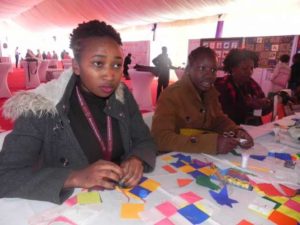
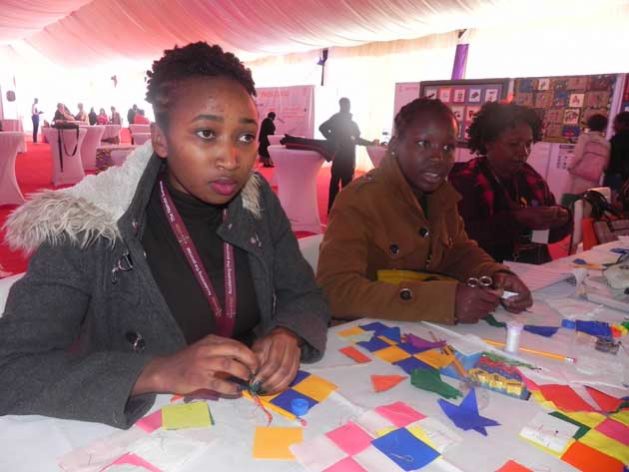
Ann Kihii (25) spends time with other young women from poor communities in Nairobi and use embroidery to create images that tell a story about the daily challenges they face. They also get a chance to discuss the issues among themselves in a safe space. Credit: Mantoe Phakathi / IPS
– While women find it hard to talk about their painful experiences, some have found a way of expressing themselves through art. Women, trained as artists, from Nairobi’s informal settlements Kibera and Kangemi, have produced a beautiful quilt that tells stories about their daily challenges.
Displayed at the Pamoja Zone of ICPD25, the quilt is used to lobby delegates to rally behind girls and women by ensuring that they enjoy sexual reproductive rights and end gender-based violence.
Being able to express yourself through art
While the embroidered quilt is a beautiful piece of work, each square that forms part of it it is sewn by different women who are expressing their sad experiences.
“I live in a community where violence against women is the order of the day,” she told IPS. “Unfortunately, women find it hard to talk about it.” Ann Kihiis (25) is one of the young women who have turned out to be a fine quilt maker. Using small square pieces of fabric, she sewed an image of a woman who was experiencing violence in her marriage.
In the same image, there is a shadow which she says symbolises the anger and hurt that an abused woman carries with her all the time unless she is able to talk about it and heal from the experience. Although she has never been in an abusive relationship, she said observing it from a young age in her family and community has traumatised her.
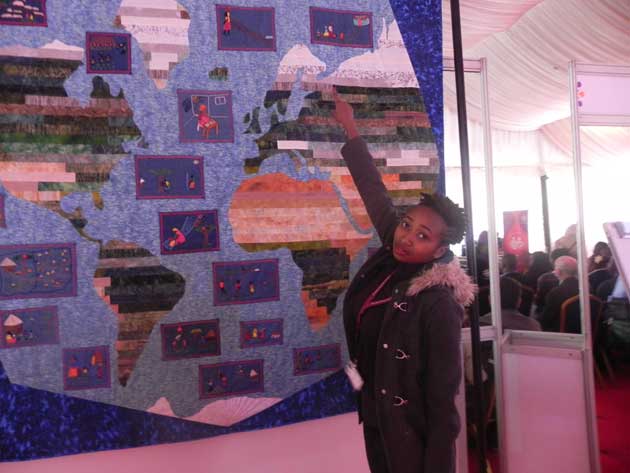
Ann Kihii showcases the quilt that she contributed in making where she designed an image of a woman in an abusive relationship who always carries the anger and hurt. Credit: Mantoe Phakathi / IPS
“I love art and this is a way of creating awareness about gender-based violence and letting people know that it’s okay to talk about it,” said Kihiis.
She said she is aware that women who are abused end up believing that they do not deserve to be loved, something that is not true.
Art brings women together
On the same quilt, other artists made images depicting crime, drugs and teenage pregnancy. For example, there is an image of a young girl who is sitting on a desk with a baby on her back. This, according to Bobbi Fitzsimmons, a quilter from the Advocacy Project is the story of a young girl who was abandoned by her father after falling pregnant. When she fell pregnant for the second time, she decided to take control of her life and returned to school even if it meant studying with much younger learners.
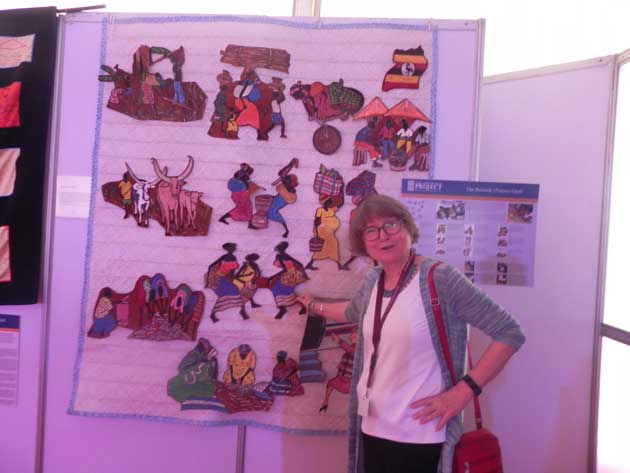
Bobbi Fitzsimmons, a quilter from The Advocacy Project, trains women groups across the world to express the challenges they face by using embroidery, painting and applique to raising awareness so as to get support in addressing gender-based violence and sexual reproductive health rights. Credit: Mantoe Phakathi / IPS
“Art is a very effective way of expressing oneself,” she said. “What’s more, the women came together while working on the quilt and discussed their issues, in what was a safe space for them to talk.”
The Kenyan women artists are trained by the Kenya Quilt Guild under Fitzsimmons’ directorship.
The United National Population Fund (UNFPA) funded The Advocacy Project to train the women. They also funded the exhibition of quilts from women in other parts of the world. For example, there is a quilt from Nepal on display with squares of paintings through which a group of women from the Eastern part of the country expresses themselves after they were treated for uterine prolapse, a painful condition affecting 600 000 women in Nepal. Another quilt donning the walls of the Pamoja Zone is one from survivors of sexual violence from the Democratic Republic of Congo, while another depicts child marriages in Zimbabwe.
In total, 18 quilts are on display at the exhibition, where delegates are fascinated by the stories.
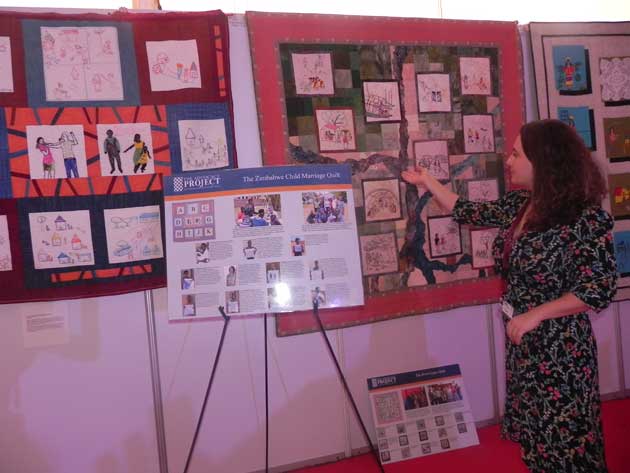
Karen Delaney, the deputy director of The Advocacy Project believes that through this initiative, women do not only come together to talk about their issues but they also get a lifetime skill for income generation. Credit: Mantoe Phakathi / IPS
In making the quilts the artists are trained to use the following skills: beadwork, painting and applique.
“Apart from the opportunity of bringing together the women, they gain skills that they can use to generate income for the rest of their lives,” said Karen Delaney, the deputy director at The Advocacy Project.